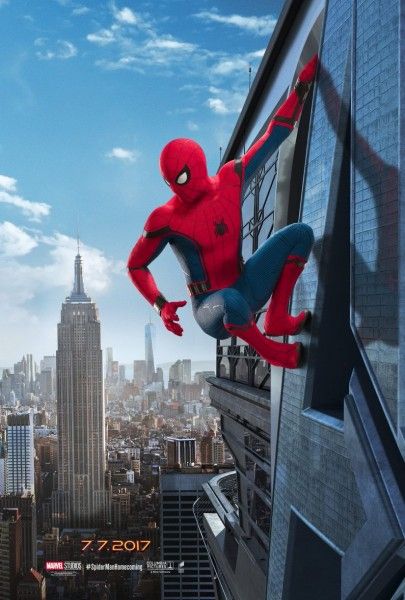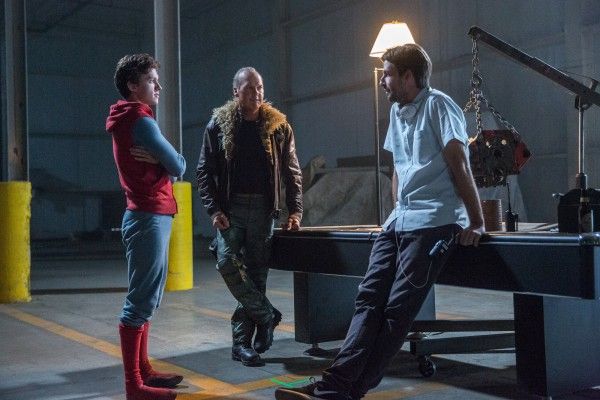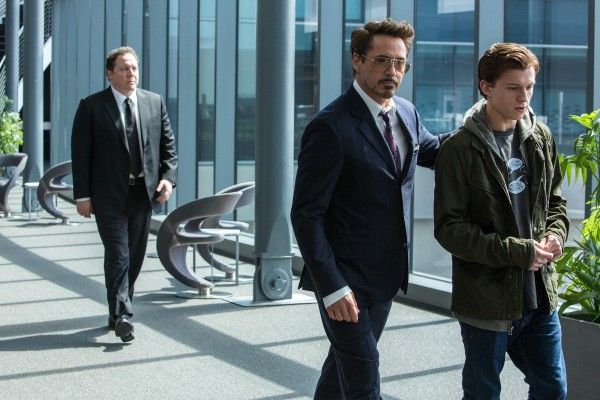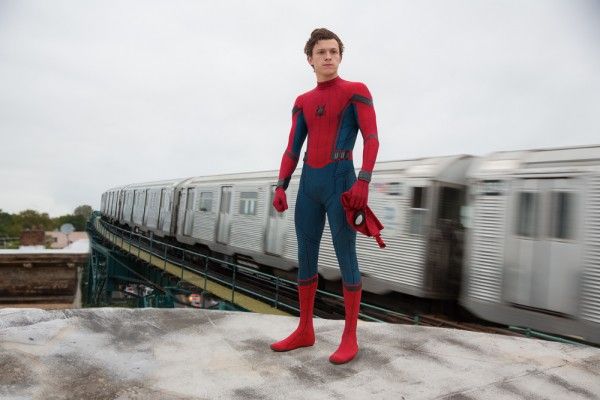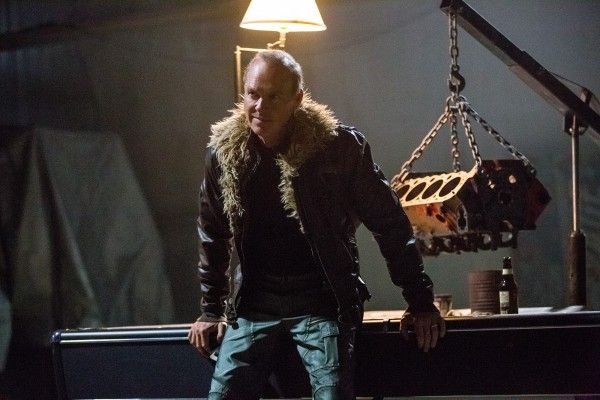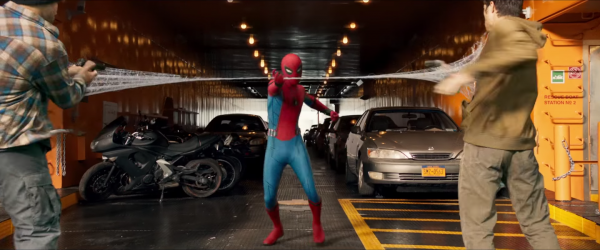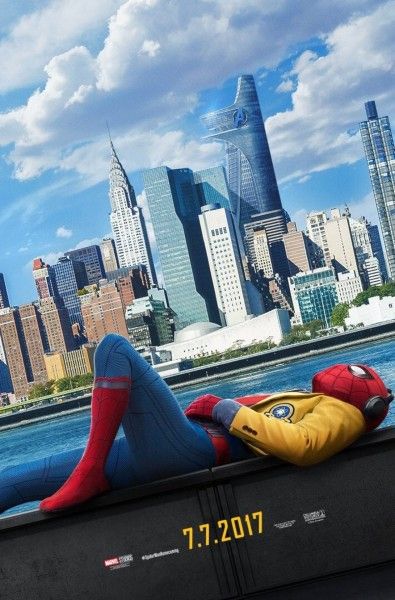Spider-Man: Homecoming is a miracle of a movie. It really shouldn’t exist. With every studio under the sun vying for its own superhero franchise, Sony Pictures has merely one property under its ownership, and that’s Spider-Man. But after a franchise reboot in two The Amazing Spider-Man films that failed to reach the critical and commercial heights that Sony was expecting, studio head and producer Amy Pascal was finally able to close a deal that until then was a pipe dream—sharing the Spider-Man character with a rival studio. Indeed, the partnership on Spider-Man: Homecoming sees Sony financing and distributing the film while Marvel Studios and Kevin Feige take the creative lead, in return letting Spider-Man exist as part of the Marvel Cinematic Universe and pop up in those Disney-distributed films from time to time.
So when I was standing on the set of Spider-Man: Homecoming in August 2016 I A. Was ecstatic to get to see the ins and outs of making a Spider-Man movie, and B. Still couldn’t quite believe these studios had come together “for the greater good” to craft a film that puts quality above competition or profit points. And quality, indeed, was on everyone’s minds while I was on set, and it was clear that the Marvel Studios folks were incredibly excited to finally get the keys to the Ferrari, so to speak.
We’ve now seen two trailers for Spider-Man: Homecoming, but I’ve learned quite a bit more about the story and approach to the film than this marketing has let on. I wouldn’t dare spoil any surprises, but below I’ve hopefully laid out Marvel’s case for why the world needs yet another Spider-Man movie, and how Homecoming fits into the larger MCU.
The film picks up a few months after the events of Captain America: Civil War, where we were first introduced to Tom Holland’s Peter Parker, and director Jon Watts’ entire theme for the film is a coming-of-age story. Indeed, Parker finds it hard to fit comfortably back into his uneventful life in Queens after having been flown across the globe by Tony Stark to battle the likes of Captain America, Ant-Man, and Falcon. It’s a bit like returning from summer camp, only to find you’re still an awkward teen at your high school.
Parker attends the Midtown School for Science and Technology, which is populated by a bunch of bright young kids but is still plagued by the same issues that affect every teen. It was important to Watts and Co. to focus heavily on Parker’s high school life, and to reflect an accurate portrayal of modern day teens in that everything seems like the biggest deal ever.
Parker struggles to straddle his two lives, one as Spider-Man fighting low-level crime on the streets, and the other as Peter Parker. Stark gave him an upgraded Spidey suit, but when Parker starts trying to tackle bigger fish in the criminal world, Stark sternly tells him to stick to pickpocketers and such, going so far as to enact a “Training Wheels” program on his suit that limits his abilities.
Enter Adrian Toomes, played by Michael Keaton. Toomes is a blue collar villain in the MCU—a guy whose salvage company was put out of business by the Department of Damage Control that just so happens to be funded by Tony Stark. Toomes is described as being akin to Tony Soprano—he doesn’t want to rule the world, he just wants to get what he feels he’s owed as a successful business owner. He and his team make a living out of scavenging alien technology and debris left over after Avengers fights, and indeed his Vulture suit was crafted out of some of this found technology.
How Vulture and Spider-Man first cross paths is left under wraps for now, but suffice it to say Peter Parker wants to prove himself as a genuine superhero worthy of being an Avenger, and doesn’t go out of his way to ask Iron Man for help.
There was a palpable excitement over this teen-centric story from those working on the film, and indeed Watts gave Holland and his co-stars a litany of 80s coming-of-age films to watch as homework. As for whether Zendaya is actually playing Mary Jane, producer Eric Carroll assured us that Zendaya is playing a character named Michelle, and when we see the movie her name will indeed be Michelle.
But Zendaya’s casting was part of a conscious decision on Watts’ part to fill out an ensemble that reflected what a real Queens high school would look like today. In other words, your entire student body is not going to be white—it’s going to be a diverse swath of kids, and that was something that was important to Watts in putting the cast together for this movie.
All of this only scratches the surface of what I learned during my brief visit to the set—where I also got to see Keaton shoot a scene in Toomes’ warehouse with Holland’s Spider-Man. Below you’ll find a series of interesting nuggets of information that I gleaned from my time in Atlanta, and along with links to full interviews and more pointed stories.
I’ve had my issues with some Marvel movies in the past, but I can confidently say that I walked away from the Spider-Man: Homecoming set optimistic that Watts and Co. have put together something that’s unique not only in the MCU, but also stands apart from the previous five Spider-Man movies we’ve seen over the last 15 years. If Watts’ character focus and John Hughes-esque tone shines through in the finished film, we could be in for something really special.
-
The film shot under the production name of Summer of George, because during development they were watching a lot of Seinfeld
- From the very start, the idea was to introduce Peter Parker in Captain America: Civil War.
- Amy Pascal says one of the things that attracted them to Jon Watts was that Cop Car showed he knew how to tell a story through action.
- Jon Watts wanted to show a “ground level” superhero story in the MCU as opposed to the “penthouse level” stories of Iron Man, Thor, etc.
- As soon as Watts got the job he was flown down to Atlanta to the set of Captain America: Civil War to consult on the Spider-Man scenes.
- Part of Watts’ pitch was telling a high school story at a school that looked like a real modern high school, not the 1950s. Watts put together a lookbook of photos of kids of all different races to show how diverse he wanted the classmates to be.
- Homecoming is a coming-of-age story, and the central Peter Parker arc is him trying to figure out which part of him is Peter and which part of him is Spider-Man.
- Watts gave the young cast members movies to watch as “homework” for the film like Say Anything, Ferris Bueller’s Day Off, Pretty in Pink, and Freaks and Geeks. Holland and the cast had a “Domino’s Day” where they ate pizza and marathoned the movies.
- In preparation for the role, Tom Holland went undercover at a public high school in the Bronx for three days with a fake name and a fake accent.
- Zendaya’s character was inspired by Ally Sheedy in The Breakfast Club and Linda Cardellini in Freaks and Geeks. She’s bookish and always has a pile of books she’s carrying around.
-
Spider-Man’s low-tech pajama suit makes an appearance in the film.
- During the audition process, Holland recorded himself on tape with the help of Joel Kinnaman and Jon Bernthal, who he was shooting movies with at the time.
- One of the scenes Marvel used to audition Holland for Spider-Man was from Whiplash, a scene between Miles Teller and J.K. Simmons’ characters. Then his final audition scene was the scene in Civil War where Tony Stark meets Peter Parker.
- Holland trained for a month before filming to show off Spider-Man abilities we haven’t seen onscreen before.
- Holland says the film shows the beginning of a sort of big brother/little brother relationship between Tony and Peter.
- The first month of shooting was all the high school scenes at a high school in Atlanta while the students were on summer break.
- Watts allowed his actors a lot of freedom to try different ideas and dialogue on set.
- The film begins at the beginning of Peter’s sophomore year.
- The first day of shooting saw Holland making practical webbing in science class, but Holland accidentally dropped the glass container and smashed it everywhere.
- Michael Keaton’s character changed quite a bit from the first version of the script to the finished film after Watts and Keaton collaborated on their approach to the character.
- The original script never specified Ned as “Ned Leeds,” but Leeds was certainly the idea of the character at the beginning.
- Hannibal Buress plays a coach at the school and Logan Marshall-Green plays a member of Michael Keaton’s team.
-
Donald Glover’s role was being kept under tight wraps while we were on set.
- The film takes place a few months after the events of Captain America: Civil War. The producers said they want to keep Peter Parker in high school for as long as possible.
- When Tony meets Peter in Civil War, he’s been fighting crime as Spider-Man for 4-6 months.
- There’s a flashback sequence in the film that shows Peter hanging out in Berlin after the big Civil War
- When he returns home he sets out to fight a lot of low-level crime, but dreams of stopping bigger baddies like The Avengers—although Tony Stark doesn’t approve.
- Aside from his adventures in Civil War, the fight against Vulture is the biggest villain he’s been up against so far.
- The origin story has not been changed from the one that everyone knows.
- There’s a Ferris Bueller-inspired chase sequence through neighborhoods.
- Vulture has kind of a “Tony Soprano mentality” in that he wants his shot at the good life and doesn’t necessarily have delusions of grandeur in terms of taking over the world.
- Adrian Toomes owns a salvage company that landed the contract to clean up after the Battle of New York, but eventually the Department of Damage Control takes over, ruining his livelihood.
- Toomes builds the Vulture suit to salvage more alien tech, and his team has in its possession Crossbones’ gauntlet from Civil War.
-
They originally thought they were going to use more CG than they ended up using, but there’s a lot of practical Spider-Man in the finished film.
- The Spidey suit has a voice inside of it and once the “training wheels” are taken off, and Peter discovers a lot of new features in the suit Tony designed.
- One of the fun things about bringing Spider-Man to the MCU is having a lot of tech-based powers and abilities.
- Peter built his webshooters and invented the web fluid on his own.
- The hologram seen at the end of Civil War allows Peter to use his high-tech web shooter and choose different settings like “swing web”, “web ball”, etc.
- There is a conversation about Uncle Ben in the movie.
- The suit has a heater, it lights up, the Spider-Man logo gives him surveillance data, there’s an airbag, and there’s a web that can tase people.
- There are no specific references to the Marvel Netflix “ground level” characters like Daredevil and Luke Cage.
- There’s no mention of Oscorp in the movie. They wanted to not mention any of the past villains or characters with a couple of exceptions like Aunt May or Flash.
- There’s also no Daily Bugle in the movie.
- All but two of the directors and writers who pitched Marvel on their Spider-Man movies had Vulture as the villain.
- The film shot for 10 days in New York City and a few pickups in Berlin, but mostly shot in Atlanta.
For more on Spider-Man: Homecoming, peruse the links to the rest of my set visit coverage below. The film opens in theaters on July 7th.
- ‘Spider-Man: Homecoming’ Star Tom Holland on the Audition Process & His Take on Peter Parker
- Michael Keaton on ‘Spider-Man: Homecoming’, Vulture’s Political Relevance, and More
- ‘Spider-Man: Homecoming’ Producer Reveals Why They Chose Vulture as the Villain
- Tom Holland Reveals How He Went Undercover at a School to Research ‘Spider-Man: Homecoming’


